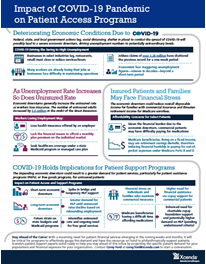How COVID-19 Will Impact Patient Support
By Corey Ford, MHA

Q: From a patient access perspective, how will the coronavirus pandemic impact the need for patient assistance programs or the number of patients who need assistance?
Corey Ford: As the COVID-19 pandemic continues to touch nearly every aspect of our way of life, the impending economic challenges portend a significant impact on patient access to critical and life-saving therapies. The unfortunate fact is, there are certain segments of the American economy where people are just not able to go to work. That leaves significant concern about a pretty heavy economic downturn. In the week ending April 4, new unemployment claims in the U.S. reached 6.6 million. We’re seeing these high numbers early from layoffs in industries like hospitality (e.g., hotels, restaurants, travel and tourism). And while we don't know what else is going to happen, we could come close to some of the highest unemployment figures we've seen in a very long time and even eclipse the Great Recession that happened about 12 years ago.
As social distancing and shelter-in-place orders threaten to generate extraordinary unemployment figures, newly-laid off workers may lose employer-sponsored health insurance or lack the resources to afford a health plan on the individual market. Down the road, the economic downturn may also drain state budgets, forcing state governments to make difficult decisions regarding Medicaid benefits and eligibility. And, even those individuals and families maintaining health insurance coverage may be forced to make difficult decisions regarding prescribed therapies, potentially necessitating a greater need for financial and copay assistance.
Given this unprecedented pandemic and its potential impact on patients across different therapeutic areas, patient support programs must be prepared to appropriately help their patient populations. Free goods or patient assistance programs (PAPs)—including bridge programs or temporary PAPs—are likely to bear the brunt of the incoming wave of demand for financial assistance.
Q: What is the broader potential impact on health insurance coverage and Medicaid?
CF: I think the primary impact is going to be a significant spike in the uninsured rate, both from a short-term and longer-term perspective.
As a point of comparison, we looked at the last economic downturn (during the Great Recession) to determine if we saw an uptick in those that were uninsured because they lost their job – either they didn't have insurance from an employer anymore or they couldn’t afford insurance because they were laid off. We saw a pretty significant spike in the uninsured from 2008 when the recession started to 2010 when it began leveling off. With some of the key changes to the Affordable Care Act (ACA) in recent years (e.g., removal of the individual mandate), we may have fewer protections in place for affected individuals.
Looking down the road, there is also an impact on state budgets given that, during an economic downturn, a state has less revenue coming in from taxes. That has a huge impact on state programs, particularly Medicaid. If this economic downturn really takes off, we could see states having to make very hard choices about what to do from a Medicaid standpoint. Maybe they have to reduce benefits; maybe they have to reduce eligibility levels. We've already seen some states explore moving to a funding approach resembling block grants for ACA expansion populations, and an economic downturn could jeopardize whether states have the funding to support these populations. If select states reduce eligibility levels, this could also drive more uninsured patients to PAP support.
Going beyond the higher uninsured rate, the economic downturn could reduce overall disposable income and purchasing power for families with commercial insurance and threaten retirement income for seniors with insurance under Medicare. Patients with commercial health insurance may have difficulty paying for medications, given the financial burden stemming from an economic downturn. This financial stress on individuals and families who maintain commercial insurance may result in a higher need for financial assistance via copay support for commercial patients. Furthermore, Medicare beneficiaries, living on a fixed income, may see retiree savings dwindle, therefore inducing financial hardship in paying for out-of-pocket expenses under Medicare Parts B and D. This could lead to an enhanced need for charitable copay foundation support and potentially higher demand on PAP (pending underinsured criteria). So, even patients with insurance are likely to be affected by the economic downturn via tighter family budgets and limited spending power, potentially forcing them to make tough decisions around adhering to prescribed treatment therapies.
Q: How much long-term planning should manufacturers be doing when it comes to making sure they’re ready to support as many patients as possible? What can they do to prepare?
CF: While we do not know how long this pandemic and the social-distancing will ultimately last, there is almost undoubtedly going to be an economic impact with an effect on health insurance access. A lot of the public health experts say that if we are thinking about this in terms of the how we’ll rebound one or two weeks from now, or even two months out, we are missing the boat. The impact will be with us for some time to come.
My colleagues and I try to help our manufacturer clients prepare for these scenarios. What if they have a big wave of incoming patients that need help because they were laid off and lost their health insurance? What if families have to make hard choices about maintaining treatment regimens because they have less disposable income? What if seniors cannot afford medications because of their retirement income being devastated?
The financial assistance provided by patient support programs is a solution. With a mounting need for patient financial services emerging in the coming weeks and months, it will be critical for programs to effectively gauge this demand and have the resources on hand to philanthropically support patients. That's where our team comes in to help manufacturers’ patient access teams conduct the patient projections and understand what the tactical demands could be on their programs. We can perform what’s called an exposure analysis that specifically projects the patient demand for a product and the dollar amount that will be needed to provide assistance for patients on a given drug. These analyses help manufacturers keep tabs on what's going on in the external environment while the team that runs the program focuses on the day-to-day operations of it.
We help manufacturers think through that. We help them anticipate different scenarios, do some contingency planning and then we help them translate what that means to an actual dollar amount. Then they can ensure the resources are on hand to make sure they can still adequately support their patient populations. Whether that’s pulling money into the assistance program or allocating more product to the specialty pharmacy for free goods. It's all about making sure they're projecting that correctly.
Q: In terms of immediate needs, with as much of the workforce going remote as possible, what innovative approaches to delivering patient and provider support are we already seeing?
CF: Our colleagues at Lash Group have been laser focused on remaining fully operational during this pandemic, which meant moving 90+% of associates to a remote work status. Knowing that PAP support is so crucial during this time, Lash Group has implemented several measures to ensure continuity of TheraCom Pharmacy (dedicated for free-goods) operations. These measures include an alternative dispensing location, social distancing of pharmacy associates, increased shift turns and enhanced sanitization.
There are additional proactive ways the experts at Lash Group are ensuring that patients will be well supported throughout this time. The World Health Organization (WHO) and Centers for Disease Control (CDC) have recommended that patients have an additional supply of medication on hand, so beginning several weeks ago, Lash Group worked with our manufacturer partners to determine if dispensing a 90-day supply of PAP medication instead of 30 would make sense for their programs. They have also worked with the relevant boards of pharmacy to get approval to send a 30-day emergency refill without provider approval if a prescription has expired. In anticipation of greater need for PAP in the coming weeks and months, we are discussing with some of our manufacturer partners if further staffing up PAP support makes sense.
Now more than ever, pharma companies have an ability to positively affect patient lives and support them through the pandemic with patient support programs. Yet less than 1 in 5 patients are aware of the services available to them from manufacturers, and only 40% of HCPs are “very aware” of manufacturer-sponsored patient services. This gap in both patient education and provider support has only been heightened given the challenges COVID-19 may place on a patient’s ability to pay for their medications.
At Xcenda, our field services teams continue to assist provider’s offices virtually to ensure patients have access to their therapies and to drive awareness and use of the patient support programs provided by our manufacturer partners. We know that “high touch” doesn’t necessarily mean physical touch. Though our field services team has always offered a virtual reimbursement and access support model, we’ve pivoted in light of the current health situation to continue delivering outstanding service to our provider offices and those patients that need assistance.
Q: What else should manufacturers and other healthcare stakeholders be thinking about to ensure patients can continue to access their therapies?
CF: I do think that things like route of administration and where patients are accessing medication really matter too. Because if you have a product that is an oral, you generally access it through the pharmacy benefit. You can still probably go to the pharmacy to get that, or you can maybe still do mail order or work with a specialty pharmacy. Now you may need greater financial assistance, but you still may be able to at least access the drug. We’re already seeing calls to action from the American Pharmacists Association to remove barriers like prior authorization and limits on early refills for maintenance drugs so that patients can continue to have uninterrupted access to medications during isolation periods, keeping those with chronic conditions healthy and pharmacies equipped to care for them.
There is a pretty big question and concern for products in therapeutic areas—particularly in oncology—in which a healthcare professional administers the product. If hospitals and facilities really start turning their attention toward only the coronavirus, what does it mean for the cancer regimens for these patients? Their immune systems are already likely compromised from chemotherapy. Do we bring them in to a hospital outpatient department to get treatment? Could we see a concerted move to home infusion, if allowed by a patient’s insurance plan? What does that do to demand for nursing support? And then, what is the adherence impact of cancelled routine appointments in other therapeutic areas? There are a lot of questions that remain to be answered and a “new normal” to evaluate across patient access.






